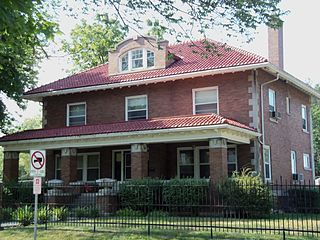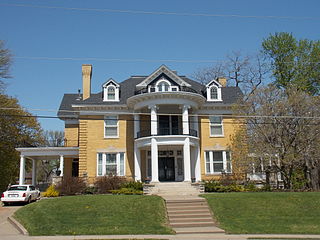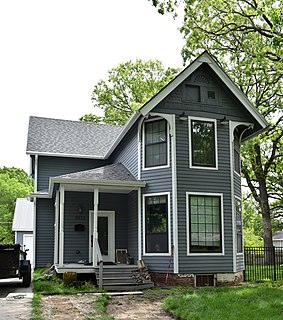Sawyer House may refer to the following locations on the National Register of Historic Places:

Sturdivant Hall, also known as the Watts-Parkman-Gillman Home, is a historic Greek Revival mansion and house museum in Selma, Alabama, United States. Completed in 1856, it was designed by Thomas Helm Lee for Colonel Edward T. Watts. It was added to the National Register of Historic Places on January 18, 1973, due to its architectural significance. Edward Vason Jones, known for his architectural work on the interiors at the White House during the 1960s and 70s, called it one of the finest Greek Revival antebellum mansions in the Southeast.

Hillside, also known as the Charles Schuler House, is a mansion overlooking the Mississippi River on the east side of Davenport, Iowa, United States. It has been individually listed on the National Register of Historic Places since 1982, and on the Davenport Register of Historic Properties since 1992. In 1984 it was included as a contributing property in the Prospect Park Historic District.

The Arthur Ebeling House is a historic building located on the west side of Davenport, Iowa, United States. The Colonial Revival house was designed by its original owner, Arthur Ebeling. It was built from 1912-1913 and it was listed on the National Register of Historic Places in 1984.

The Henry Klindt House is a historic building located in the West End of Davenport, Iowa, United States. It has been listed on the National Register of Historic Places since 1984.

The Collins House is a historic building located on the eastside of Davenport, Iowa, United States. It has been listed on the National Register of Historic Places since 1976, and on the Davenport Register of Historic Properties since 1993. Built as a farmhouse in 1860 the city of Davenport purchased the property and renovated it for a senior center in the mid 1970s.

The William V. Carr House is a historic building located in the West End of Davenport, Iowa, United States. It was built by William Carr who served as Assistant Street Commissioner, laborer, police officer, and dyer. His house is a noteworthy example of residential architecture from the time of the American Civil War. The main façade of the house has numerous architectural features. There is a projecting front piece with a round-arch entrance and two round-arch windows on the second floor. The main entrance is flanked by side bays that feature two windows with segmental heads. Above the window pairs and above the porch are recessed panels. The ends of the frontispiece and the main block of the house itself feature rusticated quoins. The house was listed on the National Register of Historic Places in 1983.

The McBride–Hickey House is a historic building located on the east side of Davenport, Iowa, United States. It has been listed on the National Register of Historic Places since 1983.

The Alois and Annie Weber House is a historic building located in Keokuk, Iowa, United States. The significance of the three-story house is its association with the period of industrial growth in the city when it was built and as a fine local example of the Second Empire style. It features an asymmetrical concave mansard roof, decorative brackets, and pedimented dormer windows. The house is noteworthy for its tall narrow windows and high ceilings. Two additions were added to the rear of the house not long after the main house was built. The Queen Anne-style wraparound porch is supported by 14 classical columns. It also features a balustrade and spindlework along the beadboard ceiling. The house was listed on the National Register of Historic Places in 2002.

The Drake University Campus Historic District is located in Des Moines, Iowa, United States. The historic district contains six buildings. Five of the buildings are collegiate buildings on the Drake University campus and one is a church. The period of significance is from when the university was founded in 1881 to the end of the presidency of Hill M. Bell in 1918. The historic district has been listed on the National Register of Historic Places since 1988. It is part of the Drake University and Related Properties in Des Moines, Iowa, 1881—1918 MPS.

The Ridge Avenue Historic District in Galesville, Wisconsin is a 5 acres (2.0 ha) historic district which was added to the National Register of Historic Places in 1984. The district contains eleven contributing properties; they are primarily located on Ridge Avenue between 4th and 6th Streets. The district was added for its architectural importance; it features buildings with Italian, Queen Anne, and other architectural styles dated between 1859 and 1934. The John F. Cance House is located near the district at 807 West Ridge Avenue.

The Selma Schricker House is a historic building located in a residential neighborhood in the West End of Davenport, Iowa, United States. At one time the house served as the official residence of Davenport's Catholic bishop. It is a contributing property in the Riverview Terrace Historic District. The district was added to the National Register of Historic Places in 1984.

Drake Public Library is a public library located in Centerville, Iowa, United States. It was established in 1901, and the building was placed on the National Register of Historic Places in 1997.

The Henry C. Wallace House is a historic residence located in Winterset, Iowa, United States. Wallace was the father of U.S. Secretary of Agriculture Henry C. Wallace, Jr. and the grandfather of U.S. Vice President Henry A. Wallace. He was a Presbyterian minister who moved to Winterset in 1877. He bought this Italianate house in 1882 from H.C. Price, who had it built. He and his wife Nanie owned the house for nine years when they sold it in March 1891. While he lived in town he became involved with the local newspaper business and bought the Winterset Chronicle and the Madisonian. He would go on to be the editor of the Iowa Homestead, a leading farm publication in Des Moines, and found Wallace's Farmer.

The John L. Etzel House is a historic building located in Clear Lake, Iowa, United States. Etzel was a local merchant and financier. He was an incorporator and served as president of the Cerro Gordo State Bank. He and his brother George founded Clear Lake Electric Light and Power Company and he served as its president. Etzel was appointed the local postmaster in 1885. He was the first person to own this house, which is an example of late Victorian eclectic design. It was one of seven similar houses that were built by local banker Frank Rogers between 1890 and 1910. Completed in 1894, the two-story frame house features an irregular plan. The second story of the main facade is cantilevered over the first story, and supported by four ornate brackets. The gabled front porch, which extends beyond the side of the house, has turned posts and gingerbread ornamentation. It was listed on the National Register of Historic Places in 1983.

The William Bostick House is a historic building located at 115 North Gilbert Street in Iowa City, Iowa.

The Jackson–Swisher House and Carriage House, also known as the Old Swisher Place, is a historic building located in Iowa City, Iowa, United States. Louis H. Jackson, who built the house, was a local attorney until he relocated to Denver, Colorado. Stephen A. Swisher, who lived here for 40 years, started an insurance agency and served as a curator and president of the State Historical Society of Iowa. Both were graduates of the University of Iowa. The house's primary significance is architectural, and it is said to have "more characteristics of the Gothic Revival than any other house in Iowa City." The steeply pitched cross gable roof is set off by bargeboards with quatrefoil and circular openings. The paired windows of various designs, the window bays, the dormer-like window above the main entrance, and the fluted chimneys lend a picturesque quality. The front porch features tracery ornamentation. The former carriage house, converted into a garage in 1946, is simpler in its ornamentation. It has paired windows on the second floor, and like the main house, there is a gentle flair at the eaves. The buildings were listed together on the National Register of Historic Places in 1982.

The Nellie and Thomas Knotts House is a historic building located in Des Moines, Iowa, United States. This two-story dwelling is a gabled-ell type house that features a chamfered front section with gable-end detail, fishscale shingles, and a hipped porch. The property on which it stands is one of ten plats that were owned by Drake University. The University sold this lot and two others to Adam Howell in 1886. He sold this lot to Harold R. Howell in 1891. Nellie J. and Thomas H. Knotts acquired the property in 1893, and the house was built the following year. Knotts was president of Iowa Printing Company and then became a manager of the Union Mutual Life Insurance Company. He and his wife resided here until at least 1907. Its significance is attributed to the effect of the University's innovative financing techniques upon the settlement of the area around the campus. The house was listed on the National Register of Historic Places in 1988.

The Lampson P. Sherman House is a historic building located in Des Moines, Iowa, United States. This 2½-story frame dwelling features crossed gables that create a cross shape, shingles in the gable ends, porch and gable end brackets, and turned porch columns. The property on which it stands is one of ten plats that were owned by Drake University. The house's significance is attributed to the effect of the University's innovative financing techniques upon the settlement of the area around the campus. Hoyt Sherman bought the property from the University Land Company in 1885. The house was built in 1888 and Sherman sold it to his brother Lampson, who was a student at Drake, two years later. The house remained in the Sherman family until 1904. It was listed on the National Register of Historic Places in 1988.

The Mrs. Marian D. Vail-Prof. Charles Noyes Kinney House is a historic building located in Des Moines, Iowa, United States. This 2½-story frame dwelling follows an irregular plan and features a truncated hipped roof, various gables, a shed-roofed front porch with turned columns, fishscale shingles, and reeded panels along the gable ends. The property on which it stands is one of ten plats that were owned by Drake University. The house's significance is attributed to the effect of the University's innovative financing techniques upon the settlement of the area around the campus. Marian Vail acquired the property in 1884, and the house was built in 1889. Her daughter Jennie was a Drake student at that time. Charles Noyes Kinney, who bought the house in 1914, taught chemistry at the University for 30 years and served as the State Chemist for around 15 years. The house was listed on the National Register of Historic Places in 1988.






















